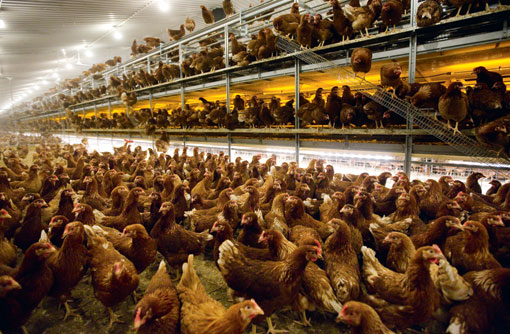Trialling a new type of multi-tier laying units

After fire devastated one of his free-range egg units last year, Mike Wilkinson decided to take a chance and build a multi-tier system thatis the first of its kind in the UK.
Problems with the supplier that Mike Wilkinson had used in the past sent him searching for alternative companies for free-range laying units.
A contact put him in touch with German outfit Farmer Automatic and he decided to install its system in a new shed on his farm near Thirsk, North Yorkshire.
Multi-tiers are commonplace in barn systems on the Continent, where Farmer Automatic has an established market. And they are growing in poularity in the UK free-range sector, as they allow more birds to be kept per square meter.
The first flock of 16,000 Bovans Brown pullets was put down on 24 January, and the birds are performing well, according to Mr Wilkinson, who says he has been encouraged by their “superb” bodyweight.
The flock is divided by low-voltage electric fences within the unit into groups of 4,000. They are being kept to RSPCA Freedom Food standards, meaning that they have access to eight acres of tree-enriched range.
The Farmer Automatic units have also been modified to comply with Freedom Food’s scheme standards – including installing an extra feed track, more perches and extra drinkers.
“The system offers feed, water and nests on each level, reducing the amount the birds need to move. The idea is to reduce the number of floor eggs and improve feed conversion,” says Mr Wilkinson. “It also gives weaker birds a better chance.”
Wire-frame ramps have been attached, allowing birds to reach the upper tiers without flying. This, says Mr Wilkinson, is both because of the breed and because pullets aren’t usually reared in the UK for multi-tier.
“They take some encouraging to use the top tier, but no more than in any other multi-tier system.”
Unusually, the Farmer Automatic system places the nesting boxes at one end of the shelving, rather than in the centre. Mr Wilkinson believes this arrangement makes access for cleaning and inspection much easier.
“The rear of the nesting box can be winched up to allow easy access to remove dead birds, or to treat for red mite,” he says.
Both tiers in the unit’s floor are on a gradual slope that, according to Farmer Automatic, increases the number of marketable eggs as they roll straight down to a belt and are removed.
The company also says that its feed trough is unique – a chain drags feed right along the system, ensuring it is more evenly distributed.
Mr Wilkinson says another thing that attracted him to the system was a scraper that runs along the floor under the lower tier; removing litter from under here, as well as a bright white light, keeps unwanted floor eggs to a minimum.
The scraper and a separate manure belt under each tier take waste to one end of the shed; eventually it is spread on 850 acres of arable land, growing wheat, barley and oilseed rape.
Training pullets for multi-tier
Farmer Automatic is introducing a pullet-rearing system to the UK which, according to the firm, will train birds to handle life in multi-tier systems from day one.
Comprising of a two-tiered cage, it is similar in design to a normal multi-tier system, complete with perches, feeders and drip trays. The big difference is that the birds can be caged in. The idea is to get them used to living between a higher and lower tier from a day old.
“Pullets are placed on chick paper in the upper tier,” explains Franz-Josef Kuhlmann, technical sales manager at Farmer Automatic. “When the chicks are strong enough, they jump out of the top tier and into the lower one.”
The entrance to the upper part of the unit is half-closed, preventing them from falling out in the early stages, but allowing them to leave when they’re able to hop over the barricade.
“This way, weaker birds can be identified and isolated,” says Mr Kuhlmann. “Gradually the birds will be split into those able to move from the higher tier to the lower one, and those which cannot.”
The system also means that 100% vaccination rates are possible.
“Lighting can also be adjusted to train them to perch at night, getting them used to a certain routine. This means that a flock can be trained to respond to the farmer’s needs – if he needs a flock that wakes up at 7am, he can use the lighting and train them to do so.”
